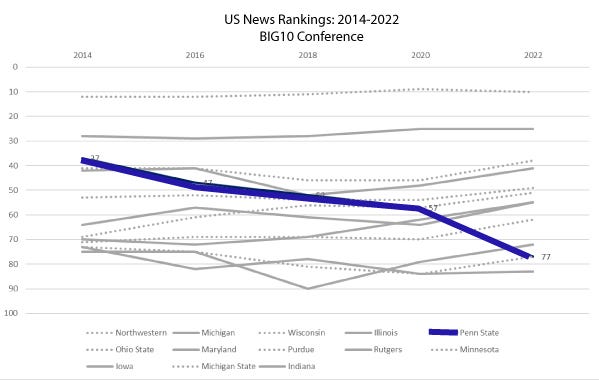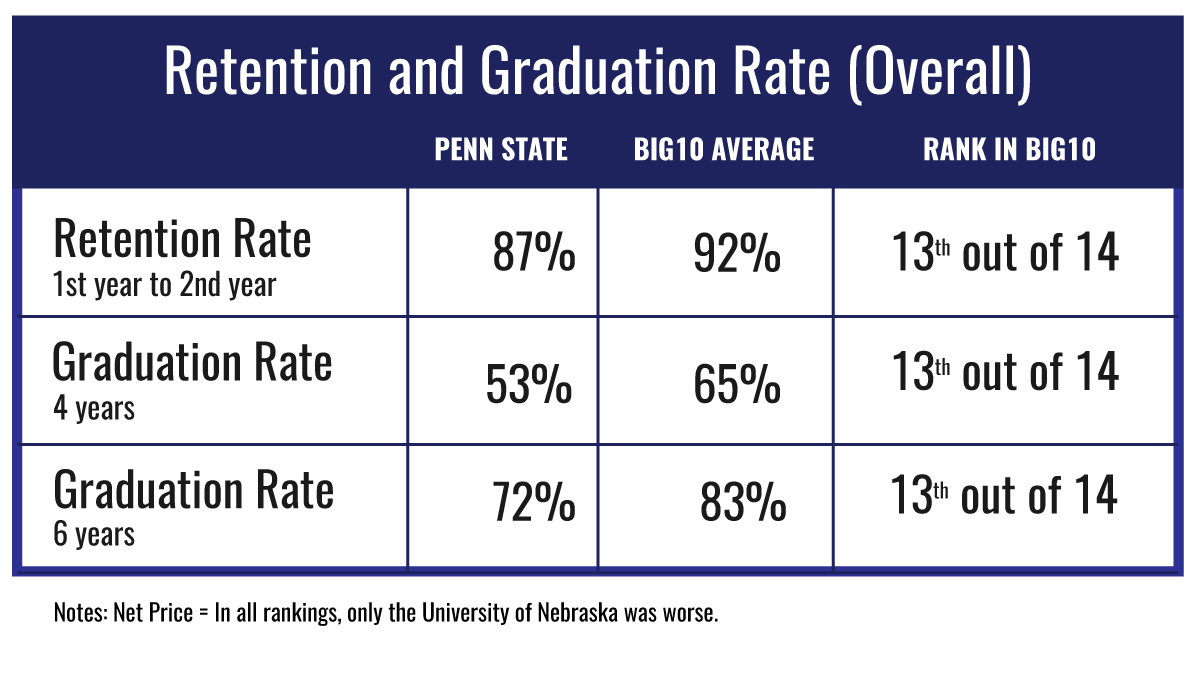Penn State's drop in academic rankings is the worst in the nation. How bad is it?
Spoiler Alert: Really bad.
US News and World Reports has a popular rating guide that is often cited by consumers as an accurate indication of a university’s standing. In the last 10 years, Penn State has plummeted in this ranking, from 37th nationally (3rd in the Big10 Conference) to 77th nationally (and 11th in the Big10). This drop is the largest of any major university in the country. During the same time, the University of Iowa dropped 10 spots, Michigan State University fell four, and the University of Nebraska was kicked out of the American Association of Universities, but the remaining fourteen Big10 universities have either maintained or improved their rankings.
Depending on where they end up, universities are either quick to praise or disparage academic rankings. Northwestern University shines in whatever metric they are ranked, while Penn State calls the rankings (in this case for law schools) “deeply flawed yet highly influential”.
But academic rating services play an important role and universities can’t disparage them because they don’t like the results. Students, parents, and philanthropists need a way to gauge a university’s quality before they invest in the product it’s offering, and quality in higher education can be difficult to measure.
Fortunately, accurate and non-subjective data is available. All universities that participate in federally-funded programs must provide detailed data to the Department of Education, which then compiles it into the Integrated Post-secondary Education Data System (known as IPEDS).
IPEDS data provides raw information on how well universities are doing in key areas. I watch three key metrics* closely: attracting and enrolling preferred students, affordability, and successful outcomes. What is obvious is that Penn State is failing badly:
Penn State is the least selective school in the Big10.
We have the lowest rate of acceptance regarding offers of admission.
The academic metrics of our incoming students are now among the lowest in the Big10.
Our net cost is the highest of our 13 Big10 public school peers.
Penn State is particularly unaffordable for low income students, who pay nearly three times the average of our Big10 peers.
The most disturbing data point, however, is in our lack of success in graduating low income students.
The six-year graduation rate of Pell Grant qualifying students (low income) is 56%.
This means that after six years, 44% of all low income students are not graduating and still have to repay loans.
Here’s how Penn State is currently performing and its status compared to its Big10 peers (for detailed metrics please click here).
Metric: Attracting and Enrolling Preferred Students
How are we doing making Penn State the preferred landing spot for talented high school students? Not good:
Penn State is the least selective university in the Big10 (Acceptance Rate)
We have the lowest rate of acceptance regarding offers of admission (Yield)
The academic metrics of our incoming students are the among the lowest in the Big10. (SAT Scores of enrolled students)
Metric: Affordability
How are we doing at providing an affordable, high-quality education? Not good:
Our net costs (tuition plus room-and-board, less scholarship and grant money) are the highest of our 13 Big10 public school peers.
Penn State is particularly unaffordable for low income students, who pay nearly three times the average of our Big10 peers.
Metric: Successful Outcomes
How are we doing retaining and graduating students? Not good:
Our retention rates and graduation rates are the second lowest in the Big Ten (ahead only of the University of Nebraska).
We are particularly dropping the ball with our low income (Pell Grant eligible) students, nearly half of whom will leave Penn State with a huge debt burden but no diploma.
The Big Picture
I was shocked by the terrible picture this raw data paints. I looked for any good news, and couldn’t find it. If you can see any, please let me know. I’d like to hear from you.
The reality is Penn State is failing to attract and enroll its preferred students, is significantly more expensive than our peers, and lags behind in delivering successful completions of academic pursuits. This is unacceptable.
All of those issues are related and are not the result of subjective rankings. All are within our power and responsibility to improve.
There is one key parameter we can positively affect immediately: a student’s ability to achieve success is directly related to their access to financial resources. Or to put it bluntly, how much money they have in their pocket. An inverse relationship between financial resources and academic success exists at all Big10 universities. But the drop off at Penn State is precipitous.
We can fix this.
Where does Penn State go from here?
I believe Penn State has a core mission to make sure our students can graduate in four years with a valuable degree that won’t leave them with crippling debt. It is clear what issues we must address to improve our performance and achieve our mission.
Penn State must first confront these realities. We have to own the actions which have brought us to this point. The past is behind us, but it’s not very far behind us. We can’t rely on our “brand” to save us, or wallow in paralyzing despair over how far we have fallen. Instead we can draw on our illustrious history for inspiration and face the challenges ahead.
* Penn State data includes aggregate Commonwealth Campuses. I am including Northwestern in my rankings because, although a private institution, they are a cohort. The University of California Los Angeles and the University of Southern California will join the Big10 Conference in 2024, bringing the total number of schools to 16.
As a member of the Penn State Board of Trustees, I will from time to time be made aware of certain confidential information. I will also engage with Trustees and administrators in private, off-the-record conversations, with the expectation of privacy on both parties. I take these expectations seriously, as they are required in order to catalyze important discussions.
As a fiduciary, it is also important that I engage in conversations with all stakeholders of the University. Stakeholders like you. Discussions will involve publicly available information and issues before the Board, as well as my personal thoughts, concerns, and ideas. I also will continue to solicit your thoughts, concerns, and ideas, and plan to engage in meaningful conversations with you on those topics. I hope that you will continue to share your concerns and ideas with me.
You can contact me via my website, barryfenchak.com.









No doubt your fellow trustees will crucify you for bringing this sad situation to the public’s attention. I recommend you remind them that the first step in fixing any problem is to identify the problem. The leaders at Penn State, specifically the past two Presidents and the BOT that tried to place blame for the Sandusky scandal on the football program, have driven a once respected public university into the gutter by every measurable metric. Thank you for standing up to the naïveté and hubris you encounter every day. We can only hope that the new President has the gumption to stand up to the weak board and woke faculty she’s inherited. Significant changes needed to dig the university out of this hole.